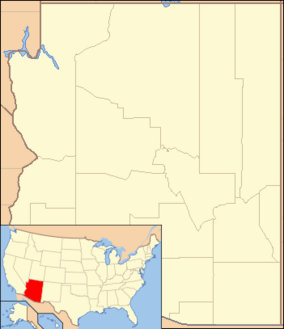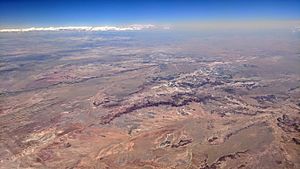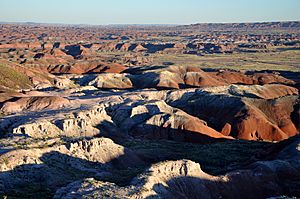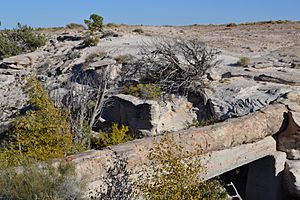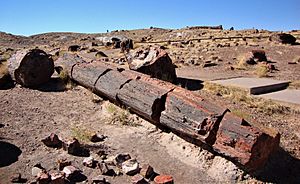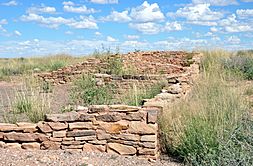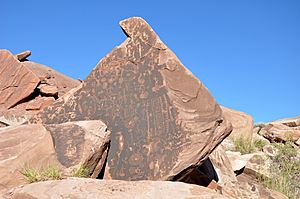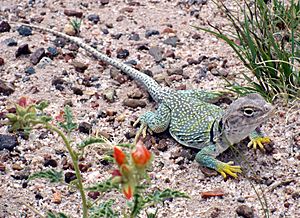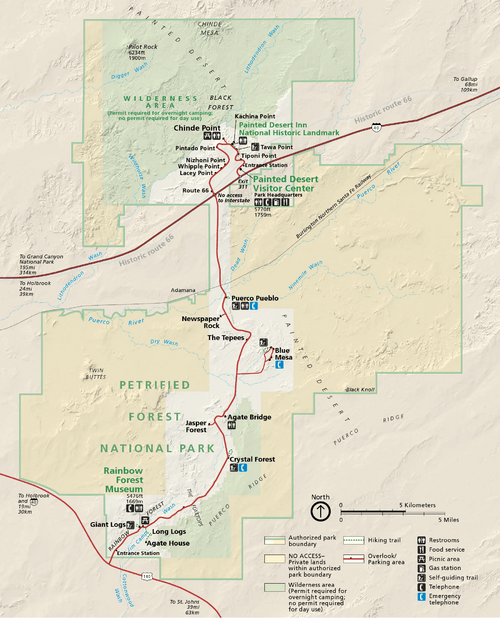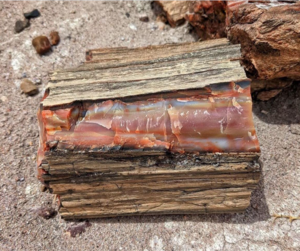Petrified Forest National Park facts for kids
Quick facts for kids Petrified Forest National Park |
|
|---|---|
|
IUCN Category II (National Park)
|
|
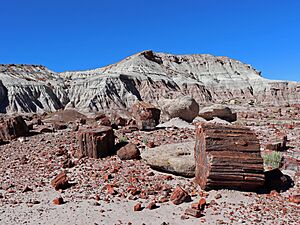
Jasper Forest at Petrified Forest NP
|
|
| Location | Arizona, United States |
| Nearest city | Holbrook |
| Area | 221,391 acres (895.94 km2) |
| Elevation | 5,436 ft (1,657 m) |
| Established |
|
| Named for | Petrified wood found in the park |
| Visitors | 644,922 (in 2018) |
| Governing body | National Park Service |
| Website | Petrified Forest National Park |
Petrified Forest National Park is a special place in northeastern Arizona, USA. It's famous for its huge amounts of petrified wood. This is wood that has turned into stone over millions of years! The park covers about 346 square miles (896 square kilometers). It has dry, shrubby areas and colorful, eroded badlands.
The park's main office is about 26 miles (42 km) east of Holbrook. A major highway, Interstate 40, runs through the park. This highway follows an old railway and the Puerco River. Part of the park also reaches into the beautiful Painted Desert. This area became a national monument in 1906 and a national park in 1962. In 2018, over 644,000 people visited the park.
The park is about 5,400 feet (1,600 meters) high. It has a dry, windy climate. Summer temperatures can reach 100°F (38°C), while winter nights can be below freezing. Over 400 types of plants grow here, mostly grasses. You can also find animals like pronghorns, coyotes, and bobcats. Many smaller creatures, such as deer mice, snakes, lizards, and seven kinds of amphibians, also live here. More than 200 types of birds visit or live in the park. About one-third of the park is a wilderness area, where human activity is limited.
Petrified Forest is a treasure chest of fossils. It's especially known for ancient fallen trees. These trees lived about 225 million years ago, during the Late Triassic period. The colorful rock layers holding these fossils are called the Chinle Formation. This is also where the Painted Desert gets its name. Around 60 million years ago, the land was pushed up by Earth's forces. This caused a lot of erosion by wind and water. Besides petrified logs, scientists have found fossils of ancient ferns, cycads, ginkgoes, giant reptiles called phytosaurs, large amphibians, and early dinosaurs. Paleontologists have been studying these fossils for over a century.
The first people arrived here about 13,000 years ago. These early Native Americans were followed by farmers about 2,500 years ago. They grew corn and lived in pit houses. Later, around 1,000 years ago, they built above-ground homes called pueblos. They also gathered in large buildings called great kivas. By 1450 CE, these farmers moved to join larger communities. Today, their descendants still live in places like the Hopi Mesas and Zuni Pueblo. Over 1,000 archeological sites, including petroglyphs (rock carvings), have been found in the park. Spanish explorers visited in the 1500s. In the mid-1800s, a U.S. team surveyed the area and noted the petrified wood. Later, roads and a railway brought tourists. Sadly, many fossils were taken before the park was protected. Even today, people still try to take petrified wood from the park.
Contents
Exploring the Park's Geography
Petrified Forest National Park is in northeastern Arizona. It sits across the border of Apache and Navajo counties. The park is about 30 miles (48 km) long from north to south. Its width changes, from about 12 miles (19 km) in the north to just 1 mile (1.6 km) in a narrow middle section.
I-40, the old U.S. Route 66, a railway, and the Puerco River all cross the park from east to west. Holbrook is the closest city, about 26 miles (42 km) west of the park's main office. A road called Park Road goes through the park from north to south. It connects I-40 in the north to U.S. Route 180 in the south. Many smaller, unpaved roads are used for park maintenance.
The park is owned by the National Park Service. It covers about 230 square miles (596 square kilometers). The Navajo Nation borders the park to the north and northeast. Other lands around the park are owned by the state, the government, or private ranchers. The park's elevation ranges from 5,340 feet (1,630 m) along the Puerco River to 6,230 feet (1,900 m) at Pilot Rock. The average height is about 5,400 feet (1,600 m). The land changes from gentle hills with lots of petrified wood in the south to eroded badlands in the north. Most of the park's streams flow into the Puerco River.
The Park's Amazing Geology
Petrified Forest National Park is famous for its fossils. Especially well-known are the fossilized trees. These trees lived about 225 to 207 million years ago. This was during the Late Triassic period of the Mesozoic era. Back then, this area was near the equator. It was a humid, sub-tropical place. Streams flowed from nearby mountains, carrying sediment and organic matter. This included trees, plants, and animals that fell into the water. Some of this organic matter was buried quickly. This allowed it to turn into fossils. The rock layers in the park that hold these fossil logs are called the Chinle Formation.
The colorful Chinle Formation is found in many parts of the southwestern U.S. It gives the Painted Desert its name. In the park, it can be up to 800 feet (240 m) thick. It's made of different kinds of sedimentary rocks. These include soft mudstone and harder sandstone. When exposed to wind and water, the Chinle Formation erodes into badlands. These badlands have cliffs, gullies, mesas, and rounded hills. The clay in the Chinle Formation swells when wet and shrinks when dry. This makes the ground move and crack, which makes it hard for plants to grow. Without plants, the Chinle Formation erodes even faster.
About 60 million years ago, Earth's crust began to push up the Colorado Plateau. The Painted Desert is part of this plateau. This uplift caused the land to rise high above sea level. It also led to a lot of erosion. In the park, most of the rock layers above the Chinle Formation have been worn away. This means there's a big gap in the rock record. Rocks from the Jurassic and Cretaceous periods are missing.
Later, about 4 to 8 million years ago, a large lake covered much of northeastern Arizona. This lake left behind layers of silt, sand, and clay. Even younger layers contain ash and lava from nearby volcanoes. Today, only a small part of these younger layers remains in the park.
During the last 2.6 million years, windblown sand and other sediments covered much of the older rocks. You can see ancient sand dunes in the park. These dunes are now covered and held in place by grasses and other plants.
Fossils: Ancient Treasures
During the Late Triassic, trees fell into river channels in what is now the park. They were buried by sediment and volcanic ash. Water then dissolved silica (a mineral) from the ash. This silica seeped into the logs. Over time, it formed quartz crystals, slowly replacing the wood. Traces of other minerals gave the petrified wood its many colors.
Most of the petrified logs in the park kept their original shape. But their insides turned to stone. However, some logs and animal bones kept their original cell structures. With these permineralized fossils, scientists can study the ancient organisms up close. Other plant and animal parts, like leaves, seeds, and insect remains, became compression fossils. These were flattened by the weight of the sediment.
Much of the petrified wood comes from an extinct conifer tree called Araucarioxylon arizonicum. At least nine types of fossil trees have been found, all now extinct. The park also has over 200 types of fossil plants. These include ferns, cycads, and ginkgoes. It's also one of the best places to find Late Triassic vertebrate fossils. Scientists have found early dinosaurs, crocodile-like reptiles, and amphibians. They have even identified new animal species here, some found nowhere else in the world.
Climate and Weather
Petrified Forest National Park has a dry, cold climate. Winter winds can be very strong, reaching 60 miles per hour (97 km/h). Summer winds are lighter, but still cause frequent sandstorms and dust devils. Some dust devils can reach thousands of feet high!
Most rain falls from July to September. August is usually the wettest month. Because the park is over 5,000 feet (1,500 m) high, it can get light snow from October to March. However, the snow usually doesn't stay on the ground for long. The air is very dry, often with less than 50 percent humidity.
| Climate data for Petrified Forest National Park, Arizona, 1991–2020 normals, extremes 1931–present | |||||||||||||
|---|---|---|---|---|---|---|---|---|---|---|---|---|---|
| Month | Jan | Feb | Mar | Apr | May | Jun | Jul | Aug | Sep | Oct | Nov | Dec | Year |
| Record high °F (°C) | 74 (23) |
77 (25) |
88 (31) |
92 (33) |
99 (37) |
107 (42) |
105 (41) |
103 (39) |
99 (37) |
92 (33) |
83 (28) |
72 (22) |
107 (42) |
| Mean maximum °F (°C) | 62.3 (16.8) |
68.6 (20.3) |
76.3 (24.6) |
83.4 (28.6) |
91.6 (33.1) |
99.8 (37.7) |
100.8 (38.2) |
97.5 (36.4) |
92.9 (33.8) |
85.6 (29.8) |
74.3 (23.5) |
64.1 (17.8) |
101.9 (38.8) |
| Mean daily maximum °F (°C) | 50.0 (10.0) |
56.4 (13.6) |
64.5 (18.1) |
72.1 (22.3) |
80.8 (27.1) |
91.4 (33.0) |
93.3 (34.1) |
90.5 (32.5) |
84.9 (29.4) |
73.9 (23.3) |
60.9 (16.1) |
49.6 (9.8) |
72.4 (22.4) |
| Daily mean °F (°C) | 35.6 (2.0) |
40.3 (4.6) |
47.1 (8.4) |
53.8 (12.1) |
62.2 (16.8) |
72.1 (22.3) |
76.7 (24.8) |
74.9 (23.8) |
68.4 (20.2) |
56.6 (13.7) |
44.5 (6.9) |
35.1 (1.7) |
55.6 (13.1) |
| Mean daily minimum °F (°C) | 21.1 (−6.1) |
24.3 (−4.3) |
29.7 (−1.3) |
35.5 (1.9) |
43.5 (6.4) |
52.7 (11.5) |
60.1 (15.6) |
59.3 (15.2) |
51.9 (11.1) |
39.3 (4.1) |
28.1 (−2.2) |
20.7 (−6.3) |
38.9 (3.8) |
| Mean minimum °F (°C) | 5.8 (−14.6) |
10.6 (−11.9) |
15.6 (−9.1) |
23.5 (−4.7) |
31.5 (−0.3) |
41.8 (5.4) |
51.5 (10.8) |
52.1 (11.2) |
39.3 (4.1) |
24.8 (−4.0) |
13.8 (−10.1) |
5.7 (−14.6) |
1.6 (−16.9) |
| Record low °F (°C) | −27 (−33) |
−8 (−22) |
2 (−17) |
12 (−11) |
19 (−7) |
31 (−1) |
42 (6) |
41 (5) |
29 (−2) |
8 (−13) |
−13 (−25) |
−18 (−28) |
−27 (−33) |
| Average precipitation inches (mm) | 0.59 (15) |
0.64 (16) |
0.65 (17) |
0.40 (10) |
0.43 (11) |
0.24 (6.1) |
1.72 (44) |
1.58 (40) |
1.02 (26) |
0.89 (23) |
0.67 (17) |
0.78 (20) |
9.61 (245.1) |
| Average snowfall inches (cm) | 0.8 (2.0) |
0.6 (1.5) |
0.8 (2.0) |
0.0 (0.0) |
0.0 (0.0) |
0.0 (0.0) |
0.0 (0.0) |
0.0 (0.0) |
0.0 (0.0) |
0.2 (0.51) |
0.3 (0.76) |
0.8 (2.0) |
3.5 (8.77) |
| Average precipitation days (≥ 0.01 in) | 5.7 | 4.8 | 4.7 | 3.3 | 3.7 | 2.2 | 8.8 | 9.4 | 5.2 | 4.9 | 3.9 | 5.3 | 61.9 |
| Average snowy days (≥ 0.1 in) | 0.5 | 0.4 | 0.3 | 0.0 | 0.0 | 0.0 | 0.0 | 0.0 | 0.0 | 0.1 | 0.1 | 0.7 | 2.1 |
| Source 1: NOAA | |||||||||||||
| Source 2: National Weather Service | |||||||||||||
A Look at History
Early People in the Park
Over 1,200 ancient sites have been found in Petrified Forest National Park. The first people arrived here more than 12,000 years ago. They used spear points made from petrified wood. Later, nomadic groups hunted animals and gathered wild plant seeds.
Around 1,000 BCE, Ancestral Pueblo farmers began to grow corn. Between 200 and 500 CE, more families moved to the area. They built houses and started living here all year. From 500 to 700 CE, families lived in shallow underground pit houses. Later, they built larger villages with many families living together. They made warm underground homes for winter. They also built above-ground rooms for storing food and daily tasks.
Around 900 CE, these farmers started building stone homes above ground. One example is Agate House, made from petrified wood, which you can still visit. Between 1050 and 1225 CE, the population grew quickly. Nearly 1,000 sites from this time have been found.
Between 1250 and 1450 CE, families lived in large apartment-like stone buildings called pueblos. These villages were often near water sources. Two big pueblos were Stone Axe and Puerco Pueblo. Puerco Pueblo had about 200 rooms around a central plaza. Perhaps 200 people lived there. Over time, these families moved to join growing towns. Their descendants still live in places like the Hopi Mesas and Zuni Pueblo today. Some think a long dry period caused people to move away. The last residents left Puerco Pueblo around 1380 CE.
At Puerco Pueblo and other sites, you can see petroglyphs. These are images or symbols carved into rock surfaces. Most petroglyphs in the park are thought to be between 650 and 2,000 years old.
From the 1500s to the 1700s, Spanish explorers passed through the area. They called it El Desierto Pintado, meaning the Painted Desert.
The Park in U.S. History
After the Southwest became part of the U.S., explorers looked for routes. In 1853, a team led by Lieutenant Amiel Whipple surveyed the area. He was so impressed by the petrified wood that he named a creek Lithodendron Creek, meaning "Stone Tree Creek." A geologist with him noted the trees were from the Triassic period.
Later, a wagon road was built. In the late 1800s, settlers and stagecoach companies used similar routes. Ranchers also grazed cattle in the Petrified Forest.
The Atlantic and Pacific Railroad opened in the 1880s. This led to towns like Holbrook. Visitors could stop at Adamana and take tours of the "Chalcedony Forest." Later, U.S. Route 66, a famous highway, ran parallel to the railroad. The park has a small section of this old road. Today, Interstate 40 crosses the park.
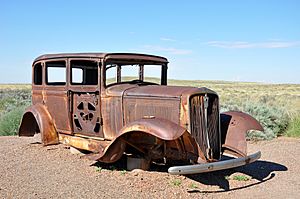
As more people visited, there was concern about petrified wood being taken. In 1895, Arizona asked the U.S. Congress to create a national park. This didn't happen right away. But in 1906, President Theodore Roosevelt used the Antiquities Act to make it the Petrified Forest National Monument. Between 1934 and 1942, the Civilian Conservation Corps built roads and trails. The monument became a national park in 1962. In 1970, parts of the park were made into wilderness areas. This means human activity is limited there. In 2004, the park was authorized to expand.
Even today, taking petrified wood is a problem. Despite park rangers and signs, about 12 kilograms (26 pounds) of fossil wood are taken each year.
Scientists have been studying the park for a long time. John Muir, a famous conservationist, did early excavations in 1905–06. He urged the government to protect the area. Since then, many archeologists and paleontologists have worked in the park. They continue to discover new things about its ancient past.
Amazing Plants and Animals
Flora: The Park's Plant Life
The park has 447 types of plants. About 57 of these are invasive, meaning they are not native and can harm local plants. Even though the park is known for its fossils and badlands, it's mostly a semi-desert grassland. Because it's been protected, it has some of the best grasslands in northeastern Arizona. The volcanic soils along the Painted Desert rim support many plants. This area is much greener than the bare badlands below.
Over 100 types of grasses grow here. Many are native to the region. You can also find flowering plants like evening primrose and blue flax. Shrubs like sagebrush are also common. Invasive plants, like annual lovegrass, can crowd out native species.
Trees and shrubs grow along the park's washes (dry stream beds). Willows and cottonwoods are larger plants found here. However, an invasive plant called tamarisk threatens native plants. It uses up most of the water and makes the soil salty.
Fauna: Animals of the Petrified Forest
Some larger animals in the grasslands include pronghorns, black-tailed jackrabbits, and Gunnison's prairie dogs. You might also see coyotes, bobcats, and foxes. Pronghorns are the fastest land animals in North America. Jackrabbits have big ears that help them cool down. Prairie dogs live in large groups called "towns." Coyotes eat many things, including rodents, fruits, and insects.
Bobcats and bullsnakes hunt smaller animals. These include deer mice and squirrels. Bats, like the western pipistrelle, eat insects. Pallid bats eat beetles, centipedes, and even scorpions. On the Painted Desert rim, small animals find shelter among the plants. Mule deer sometimes visit this area.
More than 16 kinds of lizards and snakes live in the park. They eat many insects and other small creatures. The collared lizard is the largest and most often seen.
Gopher snakes are common and sometimes pretend to be rattlesnakes. The Prairie rattlesnake is the only venomous snake here.
Seven types of amphibians live in the park. They absorb water through their skin. Tiger salamanders are the only salamander species in Arizona. Woodhouse's toads are the largest toads in the park. Red-spotted toads are active during the rainy season. The Great Plains toad is the most common toad.
Over 216 types of birds have been seen in the park since 1906. About 33 species breed here, and 18 live here all year. Many birds visit during fall and winter migrations.
You can find raptors, songbirds, and ground birds in the grasslands. The Puerco River area is good for year-round birds and migrants like warblers and killdeer. Around the visitor centers, you might see western tanagers and house finches.
Common birds include the common raven and the western meadowlark, known for its beautiful song. The Anna's hummingbird is one of the smallest birds. The golden eagle is the largest, with a wingspan of up to 7 feet (2.1 meters)!
Fun Activities at the Park
The park is open every day except Christmas. Hours change with the seasons. The Painted Desert Visitor Center and Rainbow Forest Museum offer information and movies about the park. The Painted Desert Inn is a historic museum and bookstore.
The Painted Desert Visitor Center is near the north entrance. It has a bookstore, exhibits, a restaurant, a gift shop, and a gas station. The Rainbow Forest Museum is near the south entrance. It has fossil exhibits and an interactive Triassic Virtual Tour. The Painted Desert Inn is a National Historic Landmark.
There are no campgrounds or places to stay overnight in the park. You can find hotels in nearby towns like Holbrook. You can explore the park by car, motorcycle, or bicycle. Off-road vehicles and mountain bikes are not allowed. Bicycles must stay on paved roads.
The park has seven maintained hiking trails. They range from less than 0.5 miles (0.8 km) to almost 3 miles (4.8 km) long. Pets are allowed on trails if they are on a leash. Some popular trails are Painted Desert Rim, Blue Mesa, and Crystal Forest. There are also nine "Off the Beaten Path" routes for day hikes. If you want to backpack overnight in the wilderness areas, you need a free permit. Horseback riding is also allowed in the wilderness.
Park rangers offer many programs. These include tours of the Painted Desert Inn and guided walks. The park also hosts special events for Earth Science Week and National American Indian Heritage Month. During summer weekends, local artists share cultural demonstrations. Rangers also offer educational materials for students and teachers.
See also
 In Spanish: Parque nacional del Bosque Petrificado para niños
In Spanish: Parque nacional del Bosque Petrificado para niños
- Ancestral Puebloans
- Forty Houses, Chihuahua
- Gila Cliff Dwellings National Monument
- Hohokam
- Hubbell Trading Post National Historic Site
- Kinishba Ruins
- List of national parks of the United States
- List of areas in the United States National Park System
- Mogollon culture
- Paquimé, Chihuahua
- Southwestern archaeology


